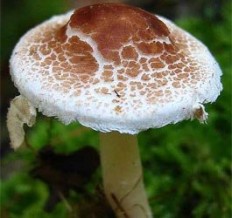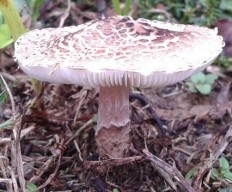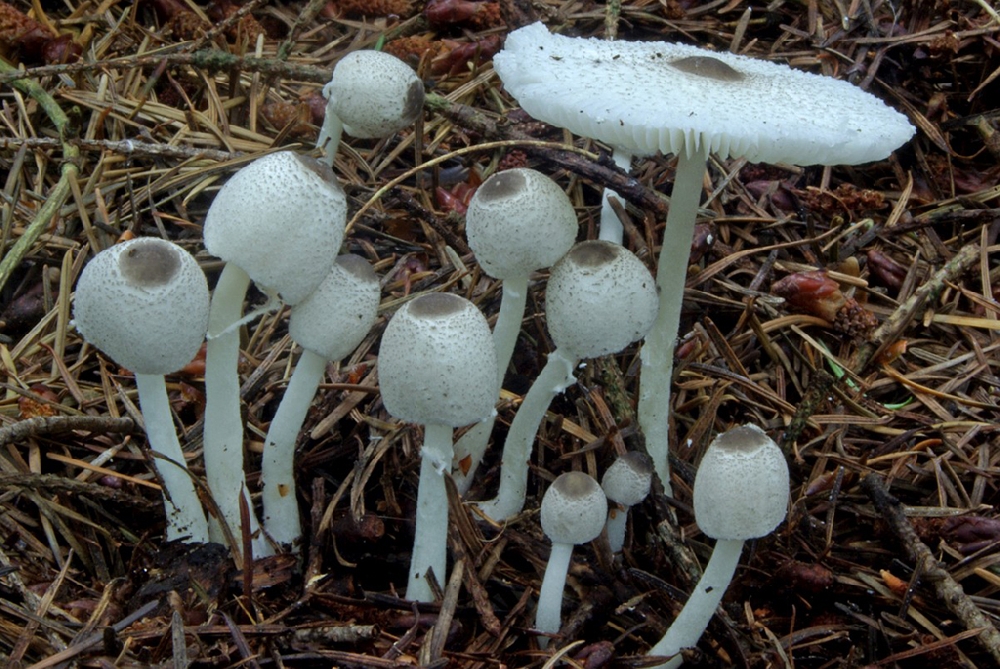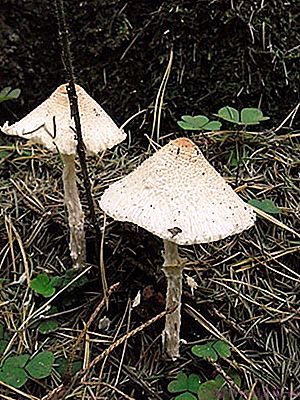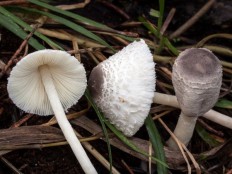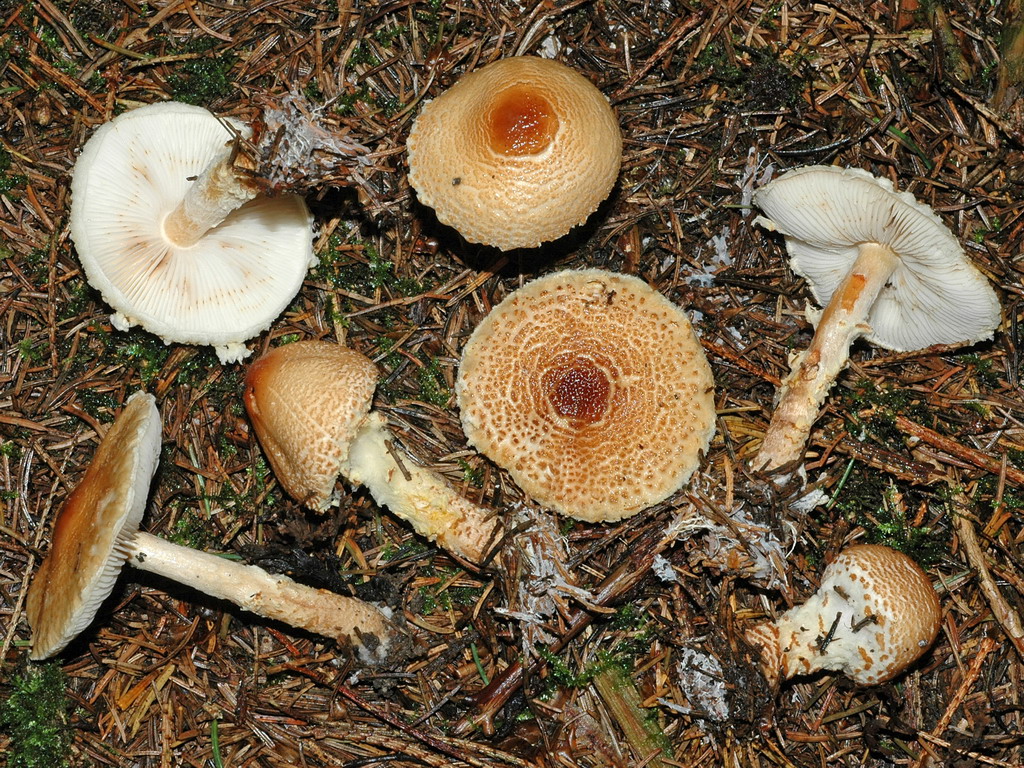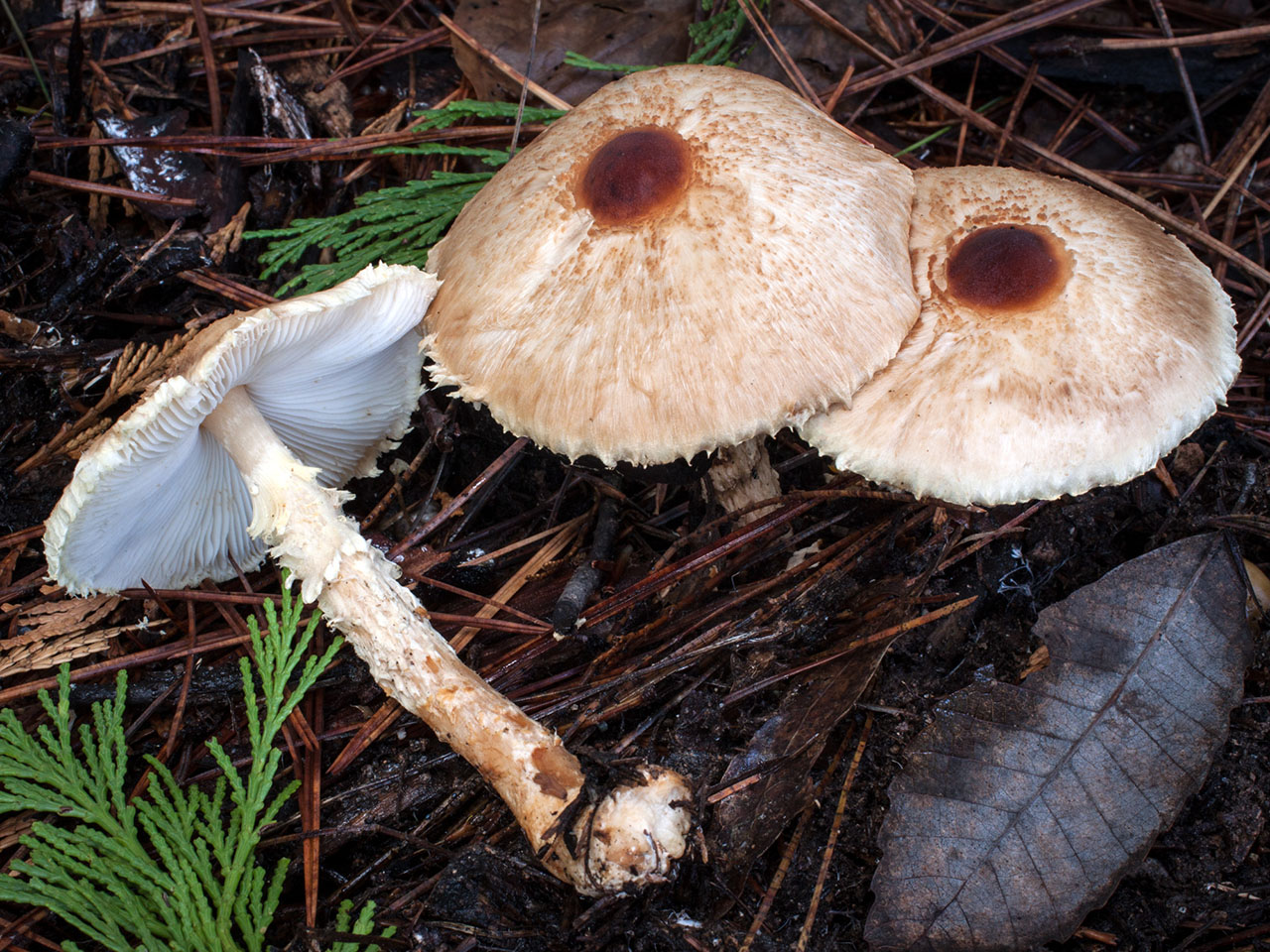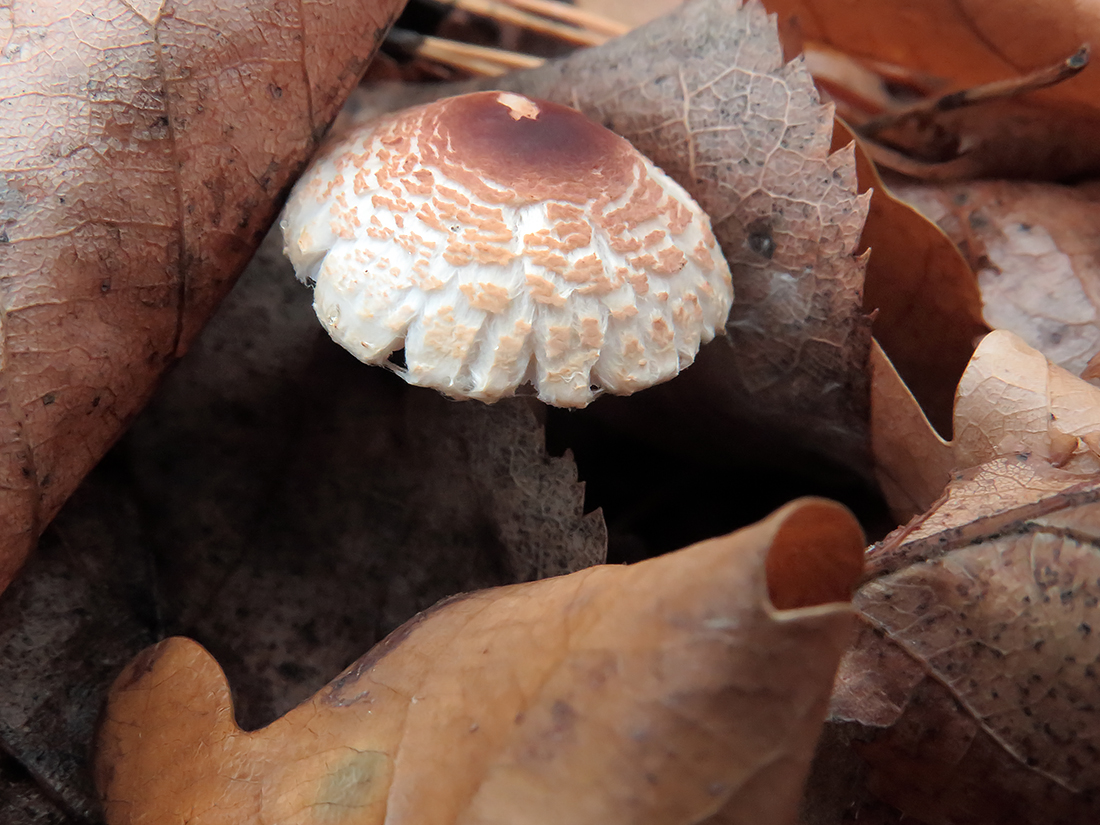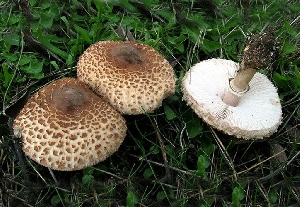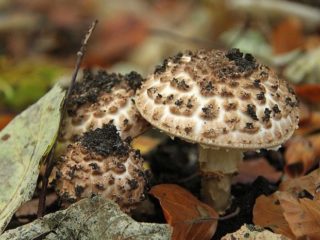(swollen umbrella)
or lepiota large spore, scaly yellowish
✎ Affiliation and generic features
Swollen lepiota (lat.Lepiota magnispora), or otherwise large-spore lepiota, scaly yellowish, or swollen umbrella is an unusual species of the genus lepiota (silverfish) (lat.Lepiota), of the large mushroom family (or agaricaceae) (lat.Agaricaceae) of the order agaric (lamellar) (lat. Agaricales).
Swollen lepiota also has a Russian name - swollen silverfish, which, in general, is related to all species of this genus, but most of all it was attached to it.
Lepiota is swollen and its food hypostases are so little studied that according to some sources it is estimated as an edible mushroom, according to other sources - absolutely inedible, and according to others - generally poisonous!
And in order not to puzzle over such scientific puzzles, and proceeding from a trifling principle: not sure - do not trust, it would be better to attribute it to the most "unused" category, namely to poisonous mushrooms!
All the more, it is worth noting that the appearance of the lepiota (silverfish) swollen, like all other lepiots, does not cause a huge appetite and desire to put it in the basket.
✎ Similar views
The swollen lepiota has a carriage of similar twins, even among its relatives, it differs from them mainly in a creamy-whitish-beige hat with thick scales located in concentric circles, connecting in the center and forming a carpet, cracking into parts, among which a yellowish pulp appears.
Swollen lepiota can be confused with cystoderm fungi (for example, amianthus cystoderm), suitable for human consumption (and now this is already incomprehensibly dangerous), with which swollen lepiota differs in the same, merging in the center of the cap, forming a closed cover with cracking scales, which are absent in cystoderms, not by the appearance of a typical ring on the pedicle, which is perfectly noticeable in cystoderms, and by the larger size of the fruiting body.
At the same time, swollen lepiota (like other species of this genus) is important not to be confused with fungi of the scaly family (due to the consonance of names), among which no poisonous species seem to be found
✎ Distribution in nature and seasonality
Swollen Lepiota is a rather rare species because it loves warmth and moisture and therefore is more common in southern latitudes, appearing as a saprotra directly on the soil, in forests of various types, usually singly.
Swollen lepiota is poorly distributed in Southern Europe, Ukraine, Crimea, Caucasus, southern regions of Russia or tropical zones of the Far East (Primorye, Kuril Islands and Sakhalin).
The active development of lepiota swollen spore begins in summer, at the beginning of August, and ends by mid or late September.
✎ Brief description and application
Swollen lepiota refers to lamellar fungi, the spores with which it reproduces are hidden in its plates. The plates are loose, frequent and terribly wide, at first white, later painted in a light cream or yellowish color. The cap is very small and in young fruits it is hemispherical or convex-bell-shaped, whitish-beige in color, but then becomes widespread with a pronounced obtuse and powerful tubercle in the middle, beige-reddish in color at the edge, light brown in the middle. The stem is cylindrical, even, fibrous, with a barely noticeable ring and the same tone as the cap or tolerably darker, covered with rather coarse white scales that darken with age. The pulp is thin, partly fragile and yellowish in the cap, reddish-brownish in the stem, but with a pleasant mushroom aroma.
It is not worth tasting bloated lepiota, because it is possibly poisonous and therefore dangerous !!!
Contraindications and benefits
Also, we strongly recommend that you refuse to cook this mushroom for food, thinking that it will improve your health.
You can take the mushroom only if you are completely sure that you will not experience allergic reactions, and also, the attending physician has approved such an intervention.
- In no case is it recommended to eat rough lepiota for children under the age of 18, even for medicinal purposes.
- Also, it is recommended to refrain from eating the mushroom by pregnant women, as well as nursing mothers.
- Do not rush to eat the mushroom if you have health problems, individual intolerances or are allergic.
Be that as it may, take care of your health, otherwise there is a possibility of poisoning.
Rough lepiota is not often found by mushroom pickers. That is why many confuse it with other prominent representatives of the mushroom kingdom. Even if you cook this mushroom, you will be disappointed by its smell, and the dish will most likely be spoiled.
When consuming alcoholic beverages, there is a high probability that you will get poisoning and other unpleasant consequences. Be as careful as possible and watch what is in your spoon. And if something is in doubt, then in this case it is recommended to check several times before starting to use or prepare.
Good luck with your mushroom hunting trips and remember that dangers can lie in wait at every turn. Therefore, be as careful as possible, this will help protect you and your loved ones from unpleasant consequences.
Poisonous Lepiota - a frail but deadly poisonous mushroom
Immature mushrooms have conical caps, a centimeter in diameter, but as they mature, they become open. The cap has a well-visible brownish-red tubercle. The surface of the mushroom is covered with a white skin dotted with sparse brown scales.
The shape of the leg is cylindrical.
The color of the leg is fawn, and the base is purple-violet. The height of the leg reaches 5 centimeters, and the diameter is up to 0.5 centimeters.
But the leg has a fragile ring. These mushrooms grow not only in forests, but also in steppes, parks, glades, and forest plantations. Lepiota Bradisson begins to actively bear fruit in the fall. Save my details for future comments. Types of mushrooms Edible mushrooms Conditionally edible mushrooms Inedible mushrooms Poisonous mushrooms Hallucinogenic mushrooms. First courses with mushrooms: recipes Second courses from mushrooms Salads with mushrooms Baking with mushrooms, pies, quiche, pizza.
Description of the poisonous lepiota
Mushrooms Lepiot mushroom brown-red. Among the kingdom of poisonous mushrooms in the middle zone of the Russian Federation, brown-red or chestnut lepiota stands apart. This representative of the forest flora is a mortal danger to humans.
Contents 1 What poisonous lepiots look like 2 Where poisonous lepiots grow 3 Is it possible to eat poisonous lepiots 4 Symptoms of poisoning 5 First aid for poisoning 6 Prevention recommendations 7 Twins and their differences 8 Conclusion. The ring is fragile, white, and may be absent in adult specimens. Cyanides cause damage to the brain and central nervous system.
Nitriles cause respiratory spasm, leading to paralysis. There is a ring on the leg of the lepiota swollen spore, which disappears with age.
Definitioner
- Basidia (Basidia)
-
Lat. Basidia. A specialized structure of sexual reproduction in fungi, inherent only in Basidiomycetes. Basidia are terminal (end) elements of hyphae of various shapes and sizes, on which spores develop exogenously (outside).
Basidia are diverse in structure and method of attachment to hyphae.
According to the position relative to the axis of the hypha, to which they are attached, three types of basidia are distinguished:
Apical basidia are formed from the terminal cell of the hypha and are located parallel to its axis.
Pleurobasidia are formed from lateral processes and are located perpendicular to the axis of the hypha, which continues to grow and can form new processes with basidia.
Subasidia are formed from a lateral process, turned perpendicular to the axis of the hypha, which, after the formation of one basidium, stops its growth.
Based on morphology:
Holobasidia - unicellular basidia, not divided by septa (see Fig. A, D.).
Phragmobasidia are divided by transverse or vertical septa, usually into four cells (see Fig. B, C).
By type of development:
Heterobasidia consists of two parts - hypobasidia and epibasidia developing from it, with or without partitions (see Fig. C, B) (see Fig. D).
Homobasidia is not divided into hypo- and epibasidia and in all cases is considered holobasidia (Fig. A).
Basidia is the place of karyogamy, meiosis and the formation of basidiospores. Homobasidia, as a rule, is not functionally divided, and meiosis follows karyogamy in it. However, basidia can be divided into probasidia - the site of karyogamy and metabasidia - the site of meiosis. Probasidium is often a dormant spore, for example in rust fungi. In such cases, probazidia grows with metabasidia, in which meiosis occurs and on which basidiospores are formed (see Fig. E).
See Karyogamy, Meiosis, Gifa.
- Pileipellis
-
Lat. Pileipellis, skin - differentiated surface layer of the cap of agaricoid basidiomycetes. The structure of the skin in most cases differs from the inner flesh of the cap and may have a different structure. The structural features of pileipellis are often used as diagnostic features in descriptions of fungi species.
According to their structure, they are divided into four main types: cutis, trichoderma, hymeniderma and epithelium.
See Agaricoid fungi, Basidiomycete, Cutis, Trichoderma, Gimeniderm, Epithelium.
- Pileipellis (Pileipellis)
-
Lat. Pileipellis, skin - differentiated surface layer of the cap of agaricoid basidiomycetes. The structure of the skin in most cases differs from the inner flesh of the cap and may have a different structure. The structural features of pileipellis are often used as diagnostic features in descriptions of fungi species.
According to their structure, they are divided into four main types: cutis, trichoderma, hymeniderma and epithelium.
See Agaricoid fungi, Basidiomycete, Cutis, Trichoderma, Gimeniderm, Epithelium.
Mushrooms with effects on the nervous system
Whitish talker
Whitish talker
Whitish talker from the Govorushka genus has a fruiting body that does not have a clear division into a leg and a cap. The diameter of the initially convex and then saucer-shaped cap with a wavy edge reaches 4 cm. The cap can have a whitish, pinkish or grayish tint.
There is a mealy bloom on the surface of the cap. Dry in hot weather, the cap becomes slimy when the humidity rises. The whitish elastic flesh of the mushroom does not darken on the cut, has a pleasant sweetish smell and a characteristic mushroom taste. The leg does not exceed 4 cm in height with a thickness of about 1 cm. In a young fruiting body, the leg is dense, as it ripens, a cavity appears in it.
The whitish talker grows in open areas of the forest, as well as in meadows and pastures, usually in groups. Fruit bodies develop from mid-summer to mid-autumn. An inexperienced mushroom picker can confuse a white talker with an edible Hanging mushroom or meadow mushroom. Therefore, if you are not sure that you have an edible hornbeam in front of you, then it is better to leave your find in place.
Whitish talker contains the poisonous substance muscarin, which leads to severe poisoning. Fortunately, it usually does not come to death, because for this you need to eat a very large amount of this type of mushroom and there is an antidote - atropine.However, vomiting, diarrhea, impaired breathing and cardiac activity are a terrible punishment for an inattentive mushroom picker and his innocent loved ones.
Fractured fiber
Fractured fiber
Fractured fiber from the genus Fiber is a very poisonous mushroom. It does not strike the eye, but if it falls into the basket of the mushroom picker, trouble cannot be avoided. To prevent this from happening, you need to carefully remember the appearance of the fissured fiber.
The caps of the young fruiting bodies of the fungus resemble a bell, and then straighten out like an umbrella, often cracking radially. Hence the name, and an indication to mushroom pickers that it is not worth taking this mushroom. Silky to the touch, slippery in wet weather, the cap can be golden yellow, pale yellow or honey brown, with the center of the cap being more intensely colored. Mushroom pulp is white with an unpleasant odor. A leg 1 cm thick will raise the cap to a height of 11 cm, it may be slightly lighter than the cap, the top of the leg is thinly mealy.
The fibula lives in forests of various types; on loamy soils, fruit bodies are especially abundant in August-September. Fractured fiber can only be confused with the May row. It is guaranteed that these mushrooms can be distinguished by their smell. At ryadovka it is flour. However, it is better not to risk it, since the fiber contains muscarine in large quantities and its use in food can end tragically.
Amanita muscaria
Amanita muscaria
Amanita by its very name speaks of its poisonous properties. And they can poison not only flies. It is good that nature has endowed the red fly agaric with such a bright appearance that cannot be confused with any mushroom. Therefore, it is very unlikely that this handsome man will end up in the mushroom picker's basket.
On a high leg up to 2.5 cm thick, as it ripens, the cap of the fruiting body rises to a height of 20 cm. By this time, it turns from a hemisphere into an elegant red umbrella with a diameter of up to 20 cm with characteristic white blotches.
Most often found in mixed forests with a predominance of conifers, on acidic soils. Fruiting in August-October. Amanita contains a number of toxic substances that, when eaten, cause hallucinations, and when ingested in large quantities, death of a person.
Theolepiota golden (Phaeolepiota aurea)
- Other names for the mushroom:
- Golden umbrella
- Mustard plaster
- Herbal flakes
Synonyms:
- Agaricus aureus
- Pholiota aurea
- Togaria aurea
- Cystoderma aureum
- Agaricus vahlii
Description of the mushroom
The cap is 5-25 cm in diameter, in youth from hemispherical to hemispherical-bell-shaped, with age it becomes convex-prostrate, with a small tubercle. The surface of the cap is matte, grainy, of a bright golden yellow, ocher yellow, ocher color, an orange tint is possible. The edge of the cap of mature mushrooms may have a fringed remnant of a private bedspread. The granularity of the cap is more pronounced at a young age, up to scaly, with age it decreases, up to disappearance. At a young age, along the edge of the cap, at the place of attachment of the private bedspread, a strip of a darker shade may appear.
The pulp is white, yellowish, may be reddish in the stem. Thick, fleshy. Without any special smell.
The plates are frequent, thin, curved, adherent. The color of the plates ranges from whitish, yellowish, pale ocher, or light clay at a young age, to rusty brown in mature mushrooms. In young mushrooms, the plates are completely covered with a dense filmy private veil of the same color as the cap, possibly a slightly darker or lighter shade.
Spore powder, rusty brown. Spores are oblong, pointed, 10..13 x 5..6 μm in size.
The leg is 5-20 cm high (up to 25), straight, with a slight thickening at the base, possibly widened in the middle, granular, matte, longitudinally wrinkled, at a young age smoothly turning into a private veil, also granular, radially wrinkled.At a young age, the granularity is very pronounced, up to scaly. The color of the leg is the same as that of the coverlet (like the cap, possibly of a darker or lighter shade). With age, the veil breaks, a wide, hanging ring remains on the leg, the color of the leg, with brown or brown-ocher scales, which can cover almost, or even the entire area, giving the veil a completely brown appearance. With age, towards the old age of the fungus, the ring decreases noticeably in size. Above the ring, the leg is smooth, at a young age, light, of the same color as the plates, there may be whitish or yellowish small flakes on it, then, with the maturation of the spores, the plates begin to darken, the leg remains lighter, but then it also darkens, reaching the same rusty brown color as the plates of the old mushroom.
Habitat
Theolepiota golden grows from the second half of July to the end of October, in groups, including large ones. Prefers rich, fertile soils - meadows, pastures, fields, grows along roads, near nettles, near bushes. Can grow in clearings in light deciduous and larch forests. The mushroom is considered rare, it is listed in the Red Book of part of the regions of Russia.
Similar species
This fungus has no similar species. However, in the photographs, when viewed from above, the pheolepiota can be confused with a ringed cap, but this is only in photographs, and only when viewed from above.
Edibility
Previously, golden pheolepiota was considered a conditionally edible mushroom, which is eaten after 20 minutes of boiling. However, now the information is contradictory, according to some reports, the mushroom accumulates cyanides, and can lead to poisoning. Therefore, recently, it is ranked among the inedible mushrooms. However, no matter how much I tried, I did not find information that someone poisoned them.
Photo: from the questions in the "Identifier".
What else is remarkable about rough lepiota?
Description of lepiota rough
The appearance of this mushroom is really memorable. Having seen him once, you definitely will not confuse him with many other representatives of mushrooms, but still, you will be careful not to rip off his poisonous counterparts.
Hat
The cap of this mushroom is bell-shaped. However, in this state, she does not stay long. Already a month after the moment the mushroom emerged from the ground, the cap takes on an umbrella-shaped shape. At the same time, a bump begins to protrude strongly in the very center. The diameter of the cap varies depending on the growing conditions and depending on the age. It varies from 5 to 10 cm. The color of the cap is rusty-brown. If you look closely at the surface itself, you will notice that it is gray with white and dark brown blotches. If you run your finger over the cap, you can feel that it is all covered with bristles, or otherwise pointed pyramidal scales. The older the mushroom, the darker shade of scales we can observe.
Let's take a look under the hat. Sharp scaly plates are hidden under it. They are very wide, loose and often spaced. It is believed that they add volume to the mushroom cap. When pressed, they begin to turn brown. The hat is also fleshy, has a white tint on the cut, but when interacting with oxygen, due to the high content of amino acids, it acquires a yellowish tint.
Leg
The stem of this sharply scaled mushroom is even and cylindrical. Its length also depends on the age and place of growth. It reaches a length of 8 to 15 cm. Its diameter is small, in relation to its height, only from one to one and a half cm. The base is slightly swollen, but very dense. The leg is more yellow below, and becomes white at the junction with the cap. Depending on the characteristics of the soil and the place of growth, the leg at the base may acquire a brown tint.
In structure, it is scaly fibrous.
Photo by Drew Parker.
In the very center of the leg there is a ring and a skirt. It is wide enough, but at the same time very thin, almost transparent. Has a film structure.The bedspread is cobweb and has a white cream shade. Sometimes there are ocher blotches on them.
The flesh at the leg is rather loose, but at the same time white. The smell is not the most delicious and pleasant, rather more disgusting.
Edibility
As mentioned above, this spiky-scaled umbrella refers to an inedible mushroom. It has a very unpleasant odor that resembles rot. Bitter taste. Decoctions of these mushrooms are distinguished by a strong resinous aroma, and sometimes even altogether, resemble burnt plastic.
Lepiota that grows on the territory of Russia and the CIS countries is really not poisonous, although not edible. However, mushrooms, which also have the name "scabrous lepiota", but growing in Europe and North America, according to foreign researchers, are deadly poisonous due to the peculiarities of the soil and the local climate.
Description of pink lepiota
The hat of a pink lepiota has a diameter of 2-5 centimeters, in shape it is convex-outstretched or flat-outstretched. The edges of the cap are slightly curved inward. Her color is ocher pink. The surface of the cap is completely covered with tightly pressed scales. The color of the plates is wine-brown.
Lepiota rosea is a lamellar fungus. The plates are free, very frequent, wide. The color of the plates is cream with a slight greenish tinge. The pulp is firm. The color of the flesh of the cap and the upper part of the leg is creamy, and the lower part of the leg is meat-colored
The stem of the serrated umbrella is cylindrical, of average length - 2.5-4 centimeters and up to 0.35 centimeters in diameter. There is a characteristic fibrous ring in the middle of the leg. Above the ring, the leg is light gray, and the lower part of it is dark gray.
Outwardly, lepiots are very similar to umbrella mushrooms, but are smaller in size. And the rest of the generic characteristics (a cap that looks like an open umbrella, fibrous scales and a motionless ring on the stem) in these fungi completely coincide.
Places of distribution of serrated umbrellas
Serrated umbrellas are common in Western Europe: France, Belgium, Italy, Denmark, Hungary, Germany, Great Britain, as well as in Russia and Kazakhstan. These mushrooms grow among the grass, in the meadows. An active growth of pink lepiota is observed from mid-June to late August. Lepiots are saprophytes, meaning they feed on decaying debris in the soil.
Toxicity of pink lepiota
In no case should you taste this mushroom - pink lepiota is a deadly poisonous species, it contains cyanides that provoke serious poisoning.
Similar species
There are about 50 species in the genus, with 7 species being classified as poisonous, and 3 as deadly poisonous, and there are also little-known edible species in the genus, for example, the small thyroid umbrella. But lepiots are very difficult to distinguish, and since there are deadly poisonous species in the genus, it is recommended not to collect these mushrooms at all.
Related species
On the territory of Russia and Europe, species such as
- Chestnut Lepiota has a cap with a diameter of 2-4 centimeters. At first, its shape is almost ovoid, and over time it becomes flat. The color of the cap is yellow-brown or red-brown with chestnut-colored felt scales. The leg length is 2-5 centimeters. These mushrooms bear fruit from July to September. They grow in forests, gardens, along ditches. They are not common. They settle in groups.
- Lepiota poisonous has a rounded cap with an unexpressed tubercle. The color of the cap is gray-red. The surface of the cap is matte with a large number of pressed scales. The leg is low, cylindrical, pink in color. It has a very fragile whitish ring. These mushrooms are found from June to August. They grow in Western Europe, Ukraine. You can find them among the grass in meadows and parks. This is a rare species. It bears fruit exclusively in autumn.
- Rough lepiota, comb lepiota, swollen lepiota and thyroid lepiota are highly suspicious of toxicity;
- Red-leaved leptiota is an edible fungus;
- Scallet lepiota is classified as conditionally edible mushrooms that are suitable for frying and boiling.

